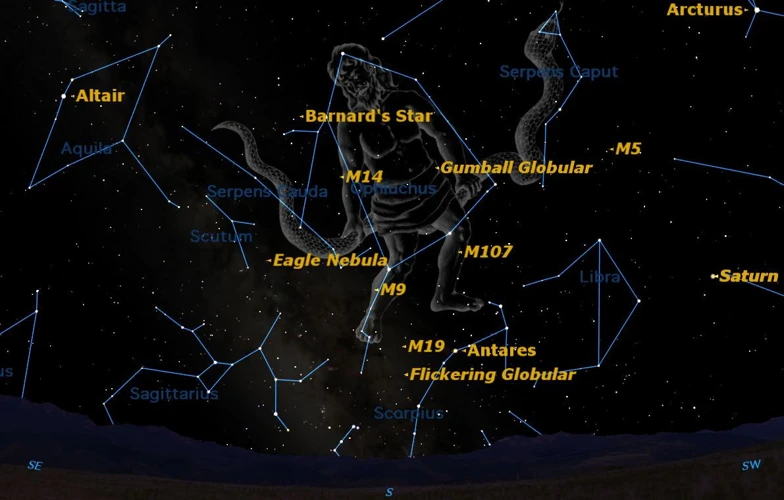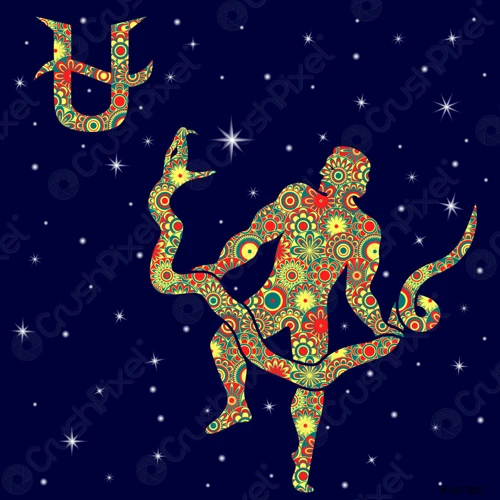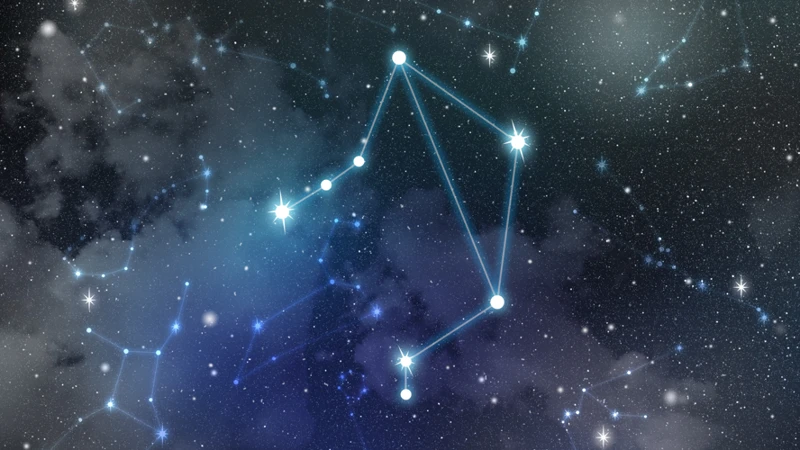Have you ever wondered why there are only 12 zodiac signs when there are 88 constellations in the night sky? Well, prepare to be astounded as we delve into the mysterious history and origin of Ophiuchus as the 13th zodiac sign. This enigmatic and often overlooked constellation, known as the Serpent Holder, has a fascinating tale behind it that dates back centuries. From its ancient origins to its controversial status in modern astrology, we will explore the significance of Ophiuchus and its impact on our understanding of the zodiac system. So, fasten your seatbelts, stargazers, as we embark on a cosmic journey to unravel the secrets of Ophiuchus.
Contents
- The Zodiac System: A Brief Overview
- Discovering Ophiuchus: A Serpent Holder Among the Stars
- Controversy and the 13th Zodiac Sign
- Historical References to Ophiuchus
- Rediscovering Ophiuchus in Modern Times
- Conclusion
-
Frequently Asked Questions
- 1. Can the zodiac signs change over time?
- 2. Is Ophiuchus recognized in mainstream astrology?
- 3. What are the dates for Ophiuchus in astrology?
- 4. What are the characteristics of Ophiuchus individuals?
- 5. Why is Ophiuchus considered the serpent holder?
- 6. How does Ophiuchus align with the sidereal zodiac?
- 7. Are there any historical references to Ophiuchus?
- 8. How did NASA impact the rediscovery of Ophiuchus?
- 9. What was the societal reaction to Ophiuchus as the 13th zodiac sign?
- 10. How can Ophiuchus be incorporated into astrological readings?
- References
-
Frequently Asked Questions
- 1. What is the significance of Ophiuchus as the 13th zodiac sign?
- 2. How does Ophiuchus relate to ancient mythology?
- 3. How does Ophiuchus affect astrological predictions?
- 4. Is Ophiuchus recognized by modern astrology?
- 5. What is the alignment between Ophiuchus and the sidereal zodiac?
- 6. How did Ophiuchus become rediscovered in modern times?
- 7. Are there references to Ophiuchus in ancient astronomical observations?
- 8. What role did Ophiuchus play in Babylonian astrology?
- 9. How did ancient Greeks interpret the constellation of Ophiuchus?
- 10. What were the societal reactions to the inclusion of Ophiuchus as a zodiac sign?
- References
- Read More
The Zodiac System: A Brief Overview

The Zodiac System, comprising of twelve zodiac signs, has captivated humanity for centuries. Its roots stretch back to ancient times, where civilizations across the globe recognized the celestial patterns in the night sky. The zodiac, derived from the Greek word “zōdiakos” meaning “circle of animals,” is a band of the sky divided into twelve equal parts, with each part representing a specific constellation. These constellations, such as Aries, Taurus, Gemini, and so on, form the basis of the zodiac system. The zodiac signs are believed to have a profound influence on individuals based on the position of the Sun at the time of their birth. Astrologers study the characteristics and traits associated with each zodiac sign to interpret personality traits and predict future events. It is important to note that while the zodiac signs are based on the positions of the constellations, they do not coincide exactly with them due to the procession of the equinoxes. The zodiac system has stood the test of time and continues to intrigue and fascinate people around the world. If you want to learn more about the captivating world of astronomy, you can explore the intriguing history of the Cassiopeia constellation or delve into the cultural significance of Ophiuchus in ancient civilizations.
Ancient Origins of the Zodiac
The ancient origins of the zodiac can be traced back to the civilizations of Mesopotamia, specifically the Sumerians and Babylonians. These early astronomers observed the movement of the Sun, Moon, and stars and developed a system to track time and define the seasons. The zodiac was a way for them to understand and interpret celestial events and their influence on earthly matters. The Sumerians divided the celestial sphere into twelve equal sections, each corresponding to a specific constellation. These early zodiac signs served as markers for navigation and agricultural purposes. Over time, the Babylonians refined the zodiac system, assigning specific meanings and characteristics to each constellation. This laid the foundation for the zodiac signs we know today. It’s fascinating to think about how these ancient civilizations, with their limited technological resources, were able to observe and interpret the celestial wonder of the night sky. The intricate connection between humans and the cosmos is truly remarkable. If you’re interested in exploring more celestial wonders, you can learn about the intriguing history of the Cassiopeia constellation or discover the cultural significance of Ophiuchus in ancient civilizations.
Traditional Zodiac Sign Placement
In the traditional zodiac system, the placement of the twelve zodiac signs follows a specific pattern. Each zodiac sign is associated with a particular timeframe during the year, representing different personality traits and characteristics. Here is a breakdown of the traditional zodiac sign placement:
1. Aries (March 21 – April 19): A fire sign, Aries is the first zodiac sign and represents courage and determination.
2. Taurus (April 20 – May 20): Taurus, an earth sign, symbolizes stability, practicality, and reliability.
3. Gemini (May 21 – June 20): The air sign Gemini is associated with intellectual curiosity, communication, and adaptability.
4. Cancer (June 21 – July 22): Cancer, a water sign, is characterized by emotional sensitivity, intuition, and nurturing qualities.
5. Leo (July 23 – August 22): Leo, a fire sign, represents leadership, creativity, and self-confidence.
6. Virgo (August 23 – September 22): Virgo, an earth sign, is known for its practicality, attention to detail, and analytical skills.
7. Libra (September 23 – October 22): Libra, an air sign, embodies balance, harmony, and a love for justice.
8. Scorpio (October 23 – November 21): Scorpio, a water sign, is associated with intensity, passion, and emotional depth.
9. Sagittarius (November 22 – December 21): Sagittarius, a fire sign, represents adventurousness, optimism, and a love for freedom.
10. Capricorn (December 22 – January 19): Capricorn, an earth sign, symbolizes ambition, discipline, and a strong sense of responsibility.
11. Aquarius (January 20 – February 18): Aquarius, an air sign, is known for its independent and progressive nature, as well as a focus on humanitarian concerns.
12. Pisces (February 19 – March 20): Pisces, a water sign, embodies empathy, creativity, and a deep spiritual connection.
Each zodiac sign has its own unique qualities and characteristics that are believed to influence individuals born under them. Understanding the positions and attributes of the traditional zodiac signs can provide insights into astrology and help individuals navigate various aspects of their lives. If you’re interested in exploring more celestial wonders, you may want to read about the intriguing history of the Cassiopeia constellation or delve into the cultural significance of Ophiuchus in ancient civilizations.
Discovering Ophiuchus: A Serpent Holder Among the Stars

Ophiuchus, the enigmatic Serpent Holder, is a constellation steeped in mystery and ancient lore. This elusive thirteenth zodiac sign lies along the celestial equator, intersecting the ecliptic, which is the apparent path of the Sun. Although Ophiuchus may not be included in the traditional zodiac, its presence is undeniable in the night sky. According to Greek mythology, Ophiuchus represents Asclepius, the legendary healer, who gained the power to resurrect the dead through a divine serpent. The constellation is often depicted as a man holding a serpent, symbolizing wisdom, healing, and spiritual transformation. Astrologically, Ophiuchus is associated with traits such as determination, intuition, and a desire for knowledge. Its position in the zodiac adds an intriguing layer of complexity to our understanding of astrological influences. To explore further celestial mysteries, you can discover the captivating exomoons – the moons of exoplanets or unravel the intriguing history of the Cassiopeia constellation, known for its iconic “W” shape.
The Mythological Tale Behind Ophiuchus
The mythological tale behind Ophiuchus is an enthralling one that originates from ancient Greece. Ophiuchus, also known as Asclepius, was a renowned healer and the son of Apollo, the god of medicine. According to the ancient legend, Ophiuchus possessed exceptional healing abilities and was able to revive the dead. This extraordinary power astounded the gods, but it also created a balance imbalance in the natural order of life and death. Hades, the god of the underworld, grew resentful and feared that Ophiuchus’s ability would disrupt the souls’ journey to the afterlife. In an act of divine intervention, Zeus struck Ophiuchus with a lightning bolt, turning him into a constellation and placing him among the stars. Today, Ophiuchus is depicted as a man grasping a serpent, symbolizing his ability to tame and harness the power of healing. This captivating myth showcases the significance and admiration ancient civilizations held for healers and the divine connection between humanity and the celestial realm. To further explore the wonders of the cosmos, you can dive into the intriguing history of the Cassiopeia constellation or unravel the cultural significance of Ophiuchus in ancient civilizations.
Astrological Significance of Ophiuchus
The astrological significance of Ophiuchus is a topic that has sparked much debate and intrigue. While traditionally excluded from the zodiac system, Ophiuchus has garnered attention and interest in recent years. Those born between November 29th and December 17th are believed to fall under the sign of Ophiuchus. This constellation is associated with the qualities of healing, wisdom, and transformation. Individuals born under Ophiuchus are thought to possess great intuition and a deep understanding of the human psyche. The serpent symbolism of Ophiuchus represents the concept of shedding old skin and embracing personal growth and rebirth. Some astrologers speculate that Ophiuchus may have a powerful influence on individuals, impacting their personality traits and life paths. While there is ongoing discussion regarding the inclusion of Ophiuchus as an official zodiac sign, its astrological significance continues to be explored. For more celestial wonders, you can explore the fascinating world of exomoons – the moons of exoplanets, or dive into the intriguing history of the Cassiopeia constellation.
Controversy and the 13th Zodiac Sign

Controversy surrounds the inclusion of the 13th zodiac sign, Ophiuchus, within the traditional zodiac system. While the zodiac system has withstood the test of time, many people were caught off guard when they discovered that their zodiac sign might have changed. This uproar came about due to the alignment of the zodiac signs with the Sun’s position during the year. Ophiuchus, the serpent holder, is said to be associated with individuals born between November 29 and December 17. This revelation sparked debates among astrologers, with some embracing the addition of Ophiuchus as the 13th zodiac sign while others dismissed it as an unnecessary modification. Despite this controversy, Ophiuchus finds alignment with the Sidereal Zodiac, which is based on the fixed positions of the constellations. It is important to note that the Sidereal Zodiac is used in Vedic astrology, which originated in ancient India. The controversy surrounding Ophiuchus has brought attention to the intricacies and interpretive nature of astrology, as well as the cultural significance of the zodiac system itself. For more fascinating insights into the cosmos, you can explore the captivating world of exomoons – the moons of exoplanets, or dive into the intriguing history of the Cassiopeia constellation.
Ophiuchus in Modern Astrology
Ophiuchus, despite its historical significance, has a controversial status in modern astrology. While the traditional zodiac system only recognizes twelve signs, there has been a growing debate about whether Ophiuchus should be officially included as the thirteenth zodiac sign. Advocates argue that Ophiuchus brings a new dimension to astrological interpretations, offering unique traits and characteristics that can resonate with individuals born between November 29th and December 17th. Ophiuchus is often associated with qualities such as wisdom, healing abilities, and a deep connection with spirituality. However, skeptics argue that introducing a 13th zodiac sign could disrupt the entire astrological system, as it would require redefining the dates and correspondences for all the signs. As a result, the inclusion of Ophiuchus in modern astrology remains a subject of debate, with astrologers and enthusiasts divided in their opinions. To gain a deeper understanding of the cosmic world, you can explore fascinating topics such as exomoons – the moons of exoplanets, the intriguing history of the Cassiopeia constellation, or the cultural significance of Ophiuchus in ancient civilizations.
Alignment with the Sidereal Zodiac
The alignment of Ophiuchus with the sidereal zodiac is a subject of ongoing debate and controversy in the realm of astrology. While the tropical zodiac, commonly used in Western astrology, is based on the position of the Sun in relation to the Earth’s equator, the sidereal zodiac takes into account the actual positions of the constellations in the sky. The sidereal zodiac follows the movement of the stars and accounts for the precession of the equinoxes, a gradual shift in the Earth’s axis over time. Interestingly, when considering the sidereal zodiac, Ophiuchus finds its place as the 13th zodiac sign, situated between Scorpio and Sagittarius. This alternative perspective challenges the traditional placement of the zodiac signs and raises questions about the accuracy and interpretation of astrological charts. Some astrologers argue that Ophiuchus should be included in the zodiac system, expanding the horoscope to include its unique characteristics and influences. However, others maintain that the tropical zodiac remains the more commonly accepted standard. Regardless of its alignment in various astrological systems, Ophiuchus continues to intrigue and fascinate those who explore the celestial wonders of the night sky. If you’re interested in more cosmic wonders, you may want to learn about the captivating exomoons, the moons of exoplanets, or discover the intriguing history of the Cassiopeia constellation.
Historical References to Ophiuchus

Historical references to Ophiuchus can be traced back to early astronomical observations and ancient astrological practices. In the field of astronomy, Ophiuchus was documented by Greek astronomer Claudius Ptolemy in the 2nd century as one of the 48 constellations listed in his catalog, the Almagest. Its name is derived from the Greek word meaning “serpent-bearer,” as the constellation appears as a figure holding a snake. In Babylonian astrology, Ophiuchus was associated with the god Imhullu, representing healing and medicine. The Babylonians recognized the constellation as a significant part of their celestial observations. In ancient Greek interpretations, Ophiuchus was often linked to the legendary healer Asclepius. Asclepius was renowned for his ability to bring the dead back to life, which stirred the concerns of the gods. Zeus eventually struck him down with a lightning bolt and immortalized him as the constellation Ophiuchus. These historical references illustrate the enduring significance and cultural interpretations of Ophiuchus throughout different civilizations. To explore more captivating aspects of astronomy, you can dive into the fascinating world of exomoons, the moons of exoplanets, or unravel the intriguing history of the Cassiopeia constellation.
Early Astronomical Observations
Early astronomical observations played a crucial role in the identification and understanding of Ophiuchus. Ancient astronomers, with their meticulous observations of the night sky, noticed the unique pattern formed by the stars in the region occupied by Ophiuchus. These early astronomers recognized the significance of this constellation and included it in their celestial maps and records. The Mesopotamians, for instance, documented their observations of Ophiuchus as early as the 5th century BCE. They recognized Ophiuchus as a prominent figure and associated it with various mythological tales and celestial events. The Babylonians, another ancient civilization renowned for their astronomical knowledge, listed Ophiuchus as one of their zodiac constellations alongside the familiar twelve. It is fascinating to note how these early observations not only acknowledged the existence of Ophiuchus but also attributed meaningful interpretations to it. As we delve deeper into the historical references to Ophiuchus, we can uncover even more intriguing connections with other celestial wonders, such as the captivating exomoons – the moons of exoplanets.
Ophiuchus in Babylonian Astrology
In Babylonian astrology, Ophiuchus held a significant place in the celestial realm. The Babylonians, who were skilled astronomers, recognized this constellation long ago and incorporated it into their astrological system. Ophiuchus was associated with the god Enki, who was known as the god of wisdom and healing. In Babylonian texts, Ophiuchus was referred to as the “Serpent Bearer” and was identified with the snake god, Ningishzida. The constellation was considered a symbol of divine knowledge and power. Interestingly, the Babylonians divided the year into twelve sections, each corresponding to a different constellation and its associated zodiac sign. However, they did not include Ophiuchus as a separate sign but rather considered it as part of the sign of Scorpio. This interpretation highlights the historical significance and reverence given to Ophiuchus in Babylonian astrology. If you’re interested in exploring more about the celestial world, you may want to discover fascinating exomoons, the moons of exoplanets, or learn about the intriguing history of the Cassiopeia constellation.
Ancient Greek Interpretations
Ancient Greek interpretations of the constellation Ophiuchus shed light on its significance in their mythology and astrology. In Greek mythology, Ophiuchus was associated with the legendary healer and demigod Asclepius. According to the myth, Asclepius possessed exceptional powers of healing and could even resurrect the dead. This connection led to the depiction of Ophiuchus as a figure holding a serpent, symbolizing wisdom and the art of medicine. In Greek astrology, Ophiuchus was not included in the traditional zodiac system of twelve signs. However, it was recognized as a powerful constellation that influenced individuals born under its sway. Ophiuchus was believed to bestow traits such as wisdom, the ability to heal, and a deep connection to spiritual and esoteric knowledge. The ancient Greeks attributed great importance to the wisdom and healing abilities associated with Ophiuchus, considering it a celestial force to be revered. To delve into more cosmic wonders, you can explore fascinating information about the exomoons – the moons of exoplanets in our vast universe, or uncover the intriguing history of the Cassiopeia constellation.
Rediscovering Ophiuchus in Modern Times

Rediscovering Ophiuchus in modern times has brought both excitement and controversy to the world of astrology. One significant event that sparked renewed interest in this celestial serpent holder was the uproar caused by a NASA blog post in 2016. The post mentioned the inclusion of Ophiuchus as the 13th zodiac sign, igniting debates among astrologers and enthusiasts alike. While the concept of Ophiuchus as a zodiac sign is not new, this incident brought it back into the spotlight. Society’s reaction to the reintroduction of Ophiuchus has been mixed, with some embracing the idea of a new zodiac sign and eagerly exploring its characteristics and implications. Others, however, remain skeptical and resist accepting Ophiuchus as part of the zodiac system. Despite the controversy, Ophiuchus has carved its place in modern astrology, forcing astrologers to reassess and redefine the zodiac landscape. Whether you choose to embrace Ophiuchus or stick to the traditional twelve signs, the rediscovery of this serpent holder has undoubtedly left an indelible mark on the astrological community. If you want to learn more about the fascinating celestial world, you can explore the intriguing history of the Cassiopeia constellation or delve into the cultural significance of Ophiuchus in ancient civilizations.
Impact of NASA’s Uproar
The revelation of Ophiuchus as the 13th zodiac sign caused quite a stir, particularly when NASA’s involvement added fuel to the fire. In 2016, NASA announced the existence of a thirteenth zodiac sign, Ophiuchus, as a result of the procession of the equinoxes. This announcement sent shockwaves through the astrological community and sparked a controversy, as it challenged the traditional understanding of the zodiac system that had been established for centuries. Many people felt confused and disoriented, wondering if their zodiac signs had changed and what this meant for their personalities and horoscopes. However, it is important to note that this revelation by NASA did not actually change the astrological signs or the way they are traditionally interpreted. Astrologers and enthusiasts voiced their concerns, arguing that the inclusion of Ophiuchus would disrupt the entire system and create chaos among believers. The uproar caused by NASA’s announcement led to heated debates and discussions about the validity and credibility of astrology. Some embraced the idea of Ophiuchus as an additional sign, expanding the zodiac system, while others dismissed it as a mere scientific interference. Amidst the chaos, if you want to explore more celestial wonder, you can dive deeper into the fascinating world of exomoons, the moons of exoplanets, or uncover the intriguing history of the Cassiopeia constellation.
Societal Reactions and Implications
The inclusion of Ophiuchus as the 13th zodiac sign has sparked a range of societal reactions and implications. When news of Ophiuchus began to spread, it created a wave of confusion and disbelief among astrology enthusiasts. Many people who identified strongly with their original zodiac sign found themselves questioning their astrological identity. Some viewed Ophiuchus as an exciting addition to the zodiac, offering a fresh perspective and new interpretations for those born under this sign. However, others expressed frustration at the sudden shift, feeling that their astrological foundations had been disrupted. Social media platforms buzzed with debates and discussions, with individuals expressing a mix of excitement, skepticism, and even anger. As a result, astrologers faced both praise and criticism for either embracing or dismissing Ophiuchus. In terms of implications, the introduction of Ophiuchus had a significant impact on horoscope publications and astrology-based industries. Horoscope writers and astrologers had to adapt their content to accommodate the new sign, creating additional work and confusion for those already entrenched in the traditional zodiac system. The debate also highlighted the evolving nature of astrology and its cultural significance. If you’re intrigued by the mysteries of the cosmos, you can explore fascinating topics like the exomoons – moons of exoplanets – or indulge in the intriguing history of the Cassiopeia constellation.
Conclusion

In conclusion, the history and origin of Ophiuchus as the 13th zodiac sign is a subject that continues to captivate astrologers and enthusiasts alike. While the inclusion of Ophiuchus in the zodiac system remains a topic of debate, its existence and significance cannot be ignored. From its mythical serpent-holding roots to its alignment with the sidereal zodiac, Ophiuchus offers a unique perspective on astrological interpretations. Historical references to Ophiuchus in early astronomical observations, Babylonian astrology, and ancient Greek interpretations further validate its presence throughout history. In modern times, Ophiuchus gained attention with NASA’s announcement, causing a stir among societal reactions and implications. Whether you choose to explore the fascinating exomoons of exoplanets or the intriguing history of the Cassiopeia constellation, the study of the stars continues to offer endless wonders and insights into the mysteries of the universe. So, keep looking up at the night sky and let the cosmic dance of the zodiac guide you on your celestial journey.
Frequently Asked Questions

1. Can the zodiac signs change over time?
While the positions of the constellations in the night sky change due to the Earth’s precession, the zodiac signs as we know them remain the same. The zodiac signs are based on the Sun’s position in relation to the Earth at the time of birth.
2. Is Ophiuchus recognized in mainstream astrology?
Ophiuchus is not widely recognized in mainstream Western astrology. The traditional zodiac system consists of twelve signs, and Ophiuchus is often excluded from astrological interpretations.
3. What are the dates for Ophiuchus in astrology?
In astrology, Ophiuchus is typically associated with the dates November 30 to December 17. However, it’s important to note that these dates can vary depending on different astrological systems.
4. What are the characteristics of Ophiuchus individuals?
Ophiuchus individuals are believed to possess traits such as wisdom, intuition, healing abilities, and a deep connection with spirituality. They are often seen as transformative and have the potential for great personal growth.
5. Why is Ophiuchus considered the serpent holder?
In Greek mythology, Ophiuchus is associated with the story of Asclepius, the god of healing. Asclepius was said to have possessed the ability to revive the dead, and his symbol was a serpent entwined around a staff, hence the serpent holder association.
6. How does Ophiuchus align with the sidereal zodiac?
Ophiuchus is included in the sidereal zodiac, which is based on the actual positions of the constellations. In this system, the Sun aligns with Ophiuchus between November 29 and December 17.
7. Are there any historical references to Ophiuchus?
Yes, historical references to Ophiuchus can be found in ancient Babylonian and Greek astrology. These civilizations recognized Ophiuchus as a distinct constellation with its own significance.
8. How did NASA impact the rediscovery of Ophiuchus?
NASA’s announcement in 2016 regarding the existence of a 13th zodiac sign received significant media attention and sparked public interest in Ophiuchus. However, it is important to note that this announcement was based on astronomical rather than astrological considerations.
9. What was the societal reaction to Ophiuchus as the 13th zodiac sign?
The introduction of Ophiuchus as a potential 13th zodiac sign created mixed reactions among astrology enthusiasts. While some embraced the idea, others remained skeptical or preferred to stick with the traditional twelve zodiac signs.
10. How can Ophiuchus be incorporated into astrological readings?
For those interested in exploring Ophiuchus in astrology, some astrologers have started incorporating this 13th sign into their readings. However, it is important to consult with a knowledgeable astrologer familiar with Ophiuchus to gain a comprehensive understanding of its potential influence.
References
- Is Ophiuchus the 13th constellation of the zodiac?
- Is Ophiuchus the 13th Zodiac Sign?
- Ophiuchus, the 13th Sign of the Zodiac – BBVA Openmind
Frequently Asked Questions

1. What is the significance of Ophiuchus as the 13th zodiac sign?
Ophiuchus represents a serpent holder and is believed to bring balance and healing energy to the zodiac. Its addition as the 13th sign challenges the traditional understanding of astrology and expands our understanding of celestial influences.
2. How does Ophiuchus relate to ancient mythology?
In ancient mythology, Ophiuchus is associated with Asclepius, the Greek god of healing. His story highlights the power of transformation and the ability to harness the hidden energies of the universe.
3. How does Ophiuchus affect astrological predictions?
With the inclusion of Ophiuchus, individuals born between November 29th and December 17th may discover new traits and characteristics that align with this sign. Astrologers are exploring how this additional sign influences personal horoscopes and compatibility.
4. Is Ophiuchus recognized by modern astrology?
While Ophiuchus is not widely recognized in traditional Western astrology, some astrologers have started to incorporate it into their interpretations. The 13th sign presents an opportunity for individuals to explore new dimensions of their personality and life experiences.
5. What is the alignment between Ophiuchus and the sidereal zodiac?
In the sidereal zodiac, Ophiuchus has always been acknowledged as a constellation. The sidereal zodiac is based on the actual positions of the constellations, while the traditional Western zodiac follows a different system that does not include Ophiuchus.
6. How did Ophiuchus become rediscovered in modern times?
Ophiuchus gained increased attention in 2011 when NASA published an article about the shift in Earth’s alignment. This sparked public interest and controversy, leading to renewed discussions and debates about the inclusion of Ophiuchus as a zodiac sign.
7. Are there references to Ophiuchus in ancient astronomical observations?
Ancient astronomers observed Ophiuchus in the night sky and recognized it as a constellation. It has been mentioned in various historical texts and star maps, highlighting its significance in ancient astronomical knowledge.
8. What role did Ophiuchus play in Babylonian astrology?
In Babylonian astrology, Ophiuchus was known as the “Serpent God” and was associated with medicine and healing. It held a prominent position alongside the other twelve zodiac signs, contributing to the understanding of cosmic influences on human lives.
9. How did ancient Greeks interpret the constellation of Ophiuchus?
Ancient Greeks identified Ophiuchus with Asclepius, the god of medicine and healing. They believed that those born under this constellation had innate healing abilities and were connected to the mysteries of life and death.
10. What were the societal reactions to the inclusion of Ophiuchus as a zodiac sign?
The introduction of Ophiuchus as the 13th zodiac sign sparked both excitement and skepticism among astrology enthusiasts. Some embraced the notion of expanded horoscope interpretations, while others regarded it as a disruption to the traditional zodiac system.
References
- The Truth Behind the ’13th Zodiac Sign’, Ophiuchus
- Is Ophiuchus the 13th constellation of the zodiac?







